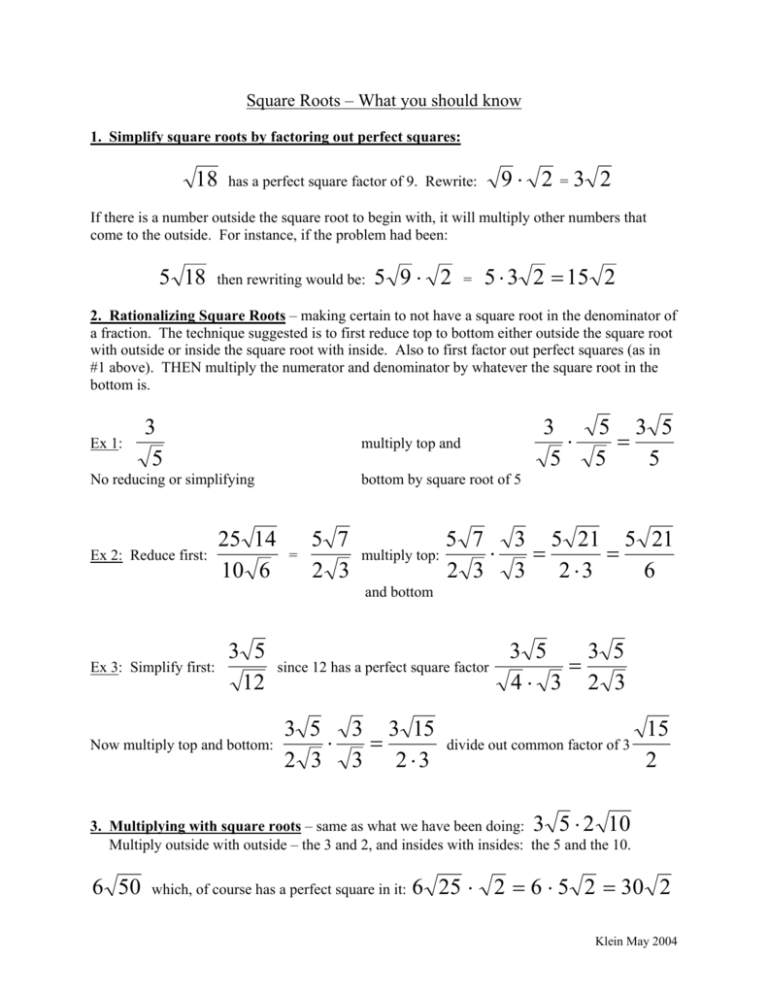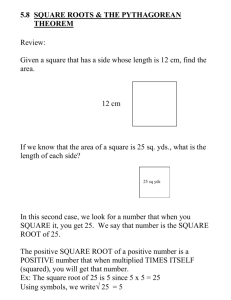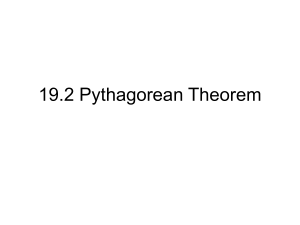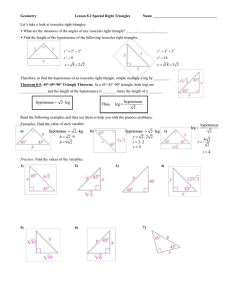Square Root Basics
advertisement

Square Roots – What you should know 1. Simplify square roots by factoring out perfect squares: 18 9⋅ 2 =3 2 has a perfect square factor of 9. Rewrite: If there is a number outside the square root to begin with, it will multiply other numbers that come to the outside. For instance, if the problem had been: 5 18 then rewriting would be: 5 9⋅ 2 = 5 ⋅ 3 2 = 15 2 2. Rationalizing Square Roots – making certain to not have a square root in the denominator of a fraction. The technique suggested is to first reduce top to bottom either outside the square root with outside or inside the square root with inside. Also to first factor out perfect squares (as in #1 above). THEN multiply the numerator and denominator by whatever the square root in the bottom is. Ex 1: 3 5 No reducing or simplifying Ex 2: Reduce first: 3 ⋅ 5 multiply top and 25 14 10 6 5 3 5 = 5 5 bottom by square root of 5 = 5 7 2 3 multiply top: 5 7 3 5 21 5 21 ⋅ = = 2 3 3 2⋅3 6 and bottom Ex 3: Simplify first: 3 5 12 Now multiply top and bottom: since 12 has a perfect square factor 3 5 3 3 15 ⋅ = 2 3 3 2⋅3 3 5 3 5 = 4⋅ 3 2 3 divide out common factor of 3 15 2 3. Multiplying with square roots – same as what we have been doing: 3 5 ⋅ 2 10 Multiply outside with outside – the 3 and 2, and insides with insides: the 5 and the 10. 6 50 which, of course has a perfect square in it: 6 25 ⋅ 2 = 6 ⋅ 5 2 = 30 2 Klein May 2004 4. Pythagorean Theorem – in a right triangle leg squared plus leg squared equals the hypotenuse squared. This is a fundamental piece of knowledge. The only issue is whether you are given two legs or a leg and the hypotenuse. Ex 1: The legs of a right triangle are 4 and 8. Determine the length of the hypotenuse. 42 + 82 = h2 simplifying: 16 + 64 = h2 Take the positive square root of each side: Ex 2: The hypotenuse of a right triangle is the other leg: Apply the theorem: 2 10 therefore: 80 = h2 h = 80 which simplifies to (since 80 is 16 times 5) and one leg is 2 x 2 + 5 = (2 10 ) 2 determine the length of 5 ⋅ 5 = 5 and 2 10 ⋅ 2 10 = 4 ⋅ 10 = 40 x 2 + 5 = 40 x 2 = 35 5 4 5 subtracting 5 from each side taking the positive square root: x = 35 5. The Pythagorean Theorem relates to distance between two points on a plane. First find slope – which are the lengths of the legs of a right triangle. Distance between (4, 5) and (-1, 2) distance: 32 + 52 = d2 9 + 25 = d2 Slope: 5− 2 4−− 1 d= = 53 34 Klein May 2004











